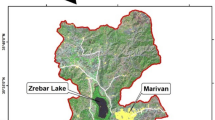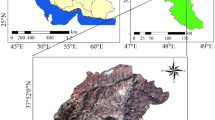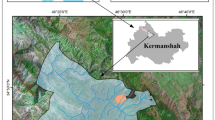Abstract
Today, competing land use is continuing to occur in many developed regions. In the Agricultural Development Zone of Western Sydney Region, which is characterised by complex landscape patterns, land use competition is widespread. From a land use planning perspective, identification of suitable locations for a given type of land use is necessary for decision makers to formulate land use alternatives in different locations, based on existing land potential and constraints. For such a region, use of a simple method that implements a categorical system and considers only inherent land characteristics in the analysis is often inadequate to arrive at an optimal spatial decision. The primary aim of this paper is to develop spatial modelling procedures for agricultural land suitability analysis using compromise programming (CoPr) and fuzzy set approach within a geographical information systems (GIS) environment. Five main sets of spatial data for use as decision criteria were developed by using fuzzy set methodology: a land suitability index (LSI) for maximising the land productivity objective; an erosion tolerance index (ETI) for minimising the erosion risk objective; a runoff curve number (CN) for maximising the water discharge regulation objective; an accessibility (RP) measure for maximising the land accessibility objective; and the proximity to water body (WP) for minimising the water pollution objective. An L p -metric was used in the analysis utilising different strategies with representative indices ranging from a situation where full tradeoff among criteria occurs to a noncompensatory condition. Different weighting combinations were also applied, and decision analysis was carried out by using values ranging from 0 to 1.0, where 1.0 is considered as an ideal point. The CoPr model demonstrated in this paper yielded a promising result, as several different techniques of sensitivity analysis show reasonably good results. Likewise, an overlay of that result with the present land use/land cover indicates a good corresponding spatial matching between existing land use (orchard and cultivated land), and the cells (land parcels) classified as the best in CoPr. The results are amenable to various map display techniques, either using continuous values or by defining different cut off points in the data space within a raster GIS environment.
Similar content being viewed by others
References
Anys, H., Bonn, F., & Merzouk, A. (1994). Remote sensing and GIS based mapping and modeling of water erosion and sediment yield in a semi-arid watershed of Morocco. Geocarto International, 1, 31–40.
Baja, S. (2001). The quality of the land: Using GIS for continuous-based land suitability assessment in the Sydney Region. GIS User, 44, 32–35.
Baja, S., Chapman, D. M., & Dragovich, D. (2001a). A conceptual model for assessing agricultural land suitability at a catchment level using a continuous approach in GIS. In Proceedings of the Geospatial Information and Agriculture Conference. 17–19 July, Sydney, 828–841.
Baja, S., Chapman, D. M., & Dragovich, D. (2001b). Fuzzy modelling of environmental suitability index for rural land use systems: An assessment using a GIS. In Proceedings of the Sixth International Conference on GeoComputation. 24–26 September, The University of Queensland, Brisbane.
Baja, S., Chapman, D. M., & Dragovich, D. (2002a). A conceptual model for defining and assessing land management units using a fuzzy modelling approach in GIS environment. Environmental Management, 29, 647–661.
Baja, S., Chapman, D. M., & Dragovich, D. (2002b). Using GIS and remote sensing for assessing and mapping the present status of land use and land qualities in the lower Hawkesbury-Nepean Catchment, Australia. Geocarto International, 17, 15–23.
Baja, S., Chapman, D. M., & Dragovich, D. (2002c). Using GIS-based continuous methods for assessing agricultural land use potential in sloping areas. Environment and Planning B: Planning and Design, 29, 3–20.
Burrough, P. A. (1989). Fuzzy mathematical methods for soil survey and land evaluation. Journal of Soil Science, 40, 477–492.
Burrough, P. A., MacMillan, R. A., & van Deursen, W. (1992). Fuzzy classification methods for determining land suitability from soil profile observations and topography. Journal of Soil Science, 43, 193–210.
Chow, V. T., Maidment, D. R., & Mays, L. W. (1988). Applied hydrology. New York: McGraw-Hill.
Davidson, D. A., Theocharopoulos, S. P., & Bloksma, R. J. (1994). A land evaluation project in Greece using GIS and based on Boolean and fuzzy set methodologies. International Journal of Geographic Information Systems, 8, 369–384.
Dilshad, M., & Peel, L. J. (1994). Evaluation of the USDA curve number method for agricultural catchments in the Australian semi-arid tropics. Australian Journal of Soil Research, 32, 673–685.
Expert Choice Inc. (1996). EC-Pro for Windows: Decision support software. McLean, VA: Decision Support Software Inc.
Graham, O. P. (1989). Land degradation survey of NSW 1987–1988: Methodology. Technical Report no. 7. Sydney: NSW Soil Conservation Service.
Jankowski, P. (1995) Integrating geographical information systems and multiple criteria decision making methods. International Journal of Geographical Information Systems, 9, 251–273.
Jones, C. A., & Kiniry, J. R. (1986). CERES-MAIZE: A simulation model of maize growth and development. Texas: A&M University Press.
Kraft, S. E., & Toohill, T. E. (1984). Soil degradation and land use change: A representative farm analysis. Journal of Soil and Water Conservation, 39, 334–338.
Lakshminarayan, P. G., Johnson, S. R., & Bouzaher, A. (1995). A multi-objective approach to integrating agricultural economic and environmental policy. Journal of Environmental Management, 45, 365–378.
Lewis, P. A. W., & Orav, E. J. (1989). Simulation methodology for statisticians, operation analysts, and engineers. Pacific Grove, CA: Wadsworth and Brooks.
Littleboy, M., Sachan, R. C., Smith, G. D., & Cogle, A. L. (1996). Soil management and production of Alfisols in the semi-arid tropics: II. Deriving USDA Curve Numbers from rainfall simulator data. Australian Journal of Soil Research, 34, 103–111.
Littleboy, M., Silburn, D. M., Freebairn, D. M., Woodruff, D. R., Hammer, G. L, & Leslie, J. K. (1992). Impact of soil erosion on production: 1. Development and validation of a simulation model. Australian Journal of Soil Research, 30, 757–774.
McCormack, D. E., Young, K. K., & Kimberlin, L. W. (1982). Current criteria for determining soil loss tolerance. In B. L. Schmidt, R. R. Allmaras, J. V. Mannering, & R. I. Papendick (Eds.), Determinants of soil loss tolerance (pp. 95–111), ASA Special Publication No. 45. Madison: Agronomy and Soil Science Society of America.
Mellerowicz, K. T., Rees, H. W., Chow, T. L., & Ghanem, I. (1994). Soil conservation planning at the watershed level using the Universal Soil Loss Equation with GIS and microcomputer: A case study. Journal of Soil and Water Conservation, 49, 194–201.
Munda, G., Nijkamp, P., & Rietveld, P. (1994). Qualitative multicriteria evaluation for environmental management. Ecological Economics, 10, 97–112.
NSW Department of Agriculture (1998). Strategic plan for sustainable agriculture, Sydney Region. Sydney: NSW Agriculture.
NSW DLWC (Department of Land and Water Conservation) (1997). Soil and landscape issues in environmental impact assessment. Technical Report No 34. Sydney: Department of Land and Water Conservation.
Pereira, J. M. C., & Duckstein, L. (1993). A multiple criteria decision making approach to GIS-based land suitability evaluation. International Journal of Geographical Information Systems, 7, 407–424.
Rallison, R. E., & Miller, N. (1982). Past, present and future SCS runoff procedure. In V. P. Singh (Ed.), Rainfall–runoff relationship (pp. 32–39). Chelsea: BookCrafters Inc.
Rawls, W. J., Ahuja, L. R., Brokensick, D. L, & Shirmohammadi, A. (1993). Infiltration and soil water movement. In D. R. Maidmet (Ed.), Handbook of Hydrology (pp. 5.1–5.51). New York: McGraw-Hill.
Romero, C., & Rehman, T. (1989). Multiple criteria analysis for agricultural decisions. Amsterdam: Elsevier.
Saaty, T. L. (1990). Multicriteria decision making: The analytic hierarchy process – planning priority setting, resource allocation. New York: McGraw-Hill.
USDA-SCS (Soil Conservation Service) (1972). National engineering Handbook: Section 4 – Hydrology. Washington, DC: U.S. Department of Agriculture.
Wischmeier W. H., & Smith, D. D. (1978). Predicting rainfall erosion losses: A guide to conservation planning. USDA Agriculture Handbook No 537. Washington, DC: U.S. Department of Agriculture.
Yet, J. Y., Silburn, D. M., Carroll, C., McKeon, G., & Willcocks, J. (1994). Improved prediction of soil moisture and runoff in pasture models. Proceedings of the 8th Biennial Conference of Australian Rangeland Society, 21–23 June, Katherine, Australian Rangeland Society, Katherine.
Young, R. A., Onstad, C. A., Bosch D. D., & Anderson, W. P. (1989). AGNPS: A non-point source pollution model for evaluating agricultural watersheds. Journal of Soil and Water Conservation, 44, 168–173.
Zeleny, M. (1982). Multiple criteria decision making. New York: McGraw-Hill.
Author information
Authors and Affiliations
Corresponding author
Rights and permissions
About this article
Cite this article
Baja, S., Chapman, D.M. & Dragovich, D. Spatial based compromise programming for multiple criteria decision making in land use planning. Environ Model Assess 12, 171–184 (2007). https://doi.org/10.1007/s10666-006-9059-1
Received:
Accepted:
Published:
Issue Date:
DOI: https://doi.org/10.1007/s10666-006-9059-1




